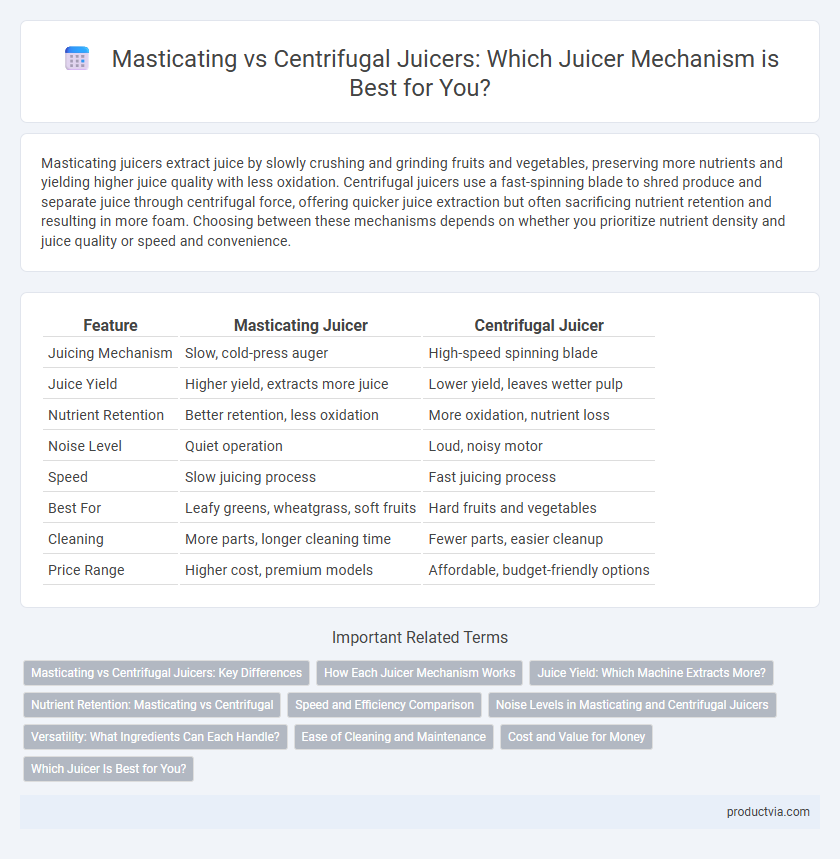Masticating juicers extract juice by slowly crushing and grinding fruits and vegetables, preserving more nutrients and yielding higher juice quality with less oxidation. Centrifugal juicers use a fast-spinning blade to shred produce and separate juice through centrifugal force, offering quicker juice extraction but often sacrificing nutrient retention and resulting in more foam. Choosing between these mechanisms depends on whether you prioritize nutrient density and juice quality or speed and convenience.
Table of Comparison
| Feature | Masticating Juicer | Centrifugal Juicer |
|---|---|---|
| Juicing Mechanism | Slow, cold-press auger | High-speed spinning blade |
| Juice Yield | Higher yield, extracts more juice | Lower yield, leaves wetter pulp |
| Nutrient Retention | Better retention, less oxidation | More oxidation, nutrient loss |
| Noise Level | Quiet operation | Loud, noisy motor |
| Speed | Slow juicing process | Fast juicing process |
| Best For | Leafy greens, wheatgrass, soft fruits | Hard fruits and vegetables |
| Cleaning | More parts, longer cleaning time | Fewer parts, easier cleanup |
| Price Range | Higher cost, premium models | Affordable, budget-friendly options |
Masticating vs Centrifugal Juicers: Key Differences
Masticating juicers use a slow, cold-press mechanism to extract juice, preserving more nutrients and enzymes for higher-quality juice compared to centrifugal juicers. Centrifugal juicers operate at high speeds, rapidly shredding fruits and vegetables, which generates heat and oxidation, potentially reducing juice shelf life and nutrient content. Masticating models tend to produce more juice with less foam and are better suited for leafy greens, whereas centrifugal juicers are faster and often more affordable for beginners.
How Each Juicer Mechanism Works
Masticating juicers operate by slowly grinding fruits and vegetables with an auger, effectively extracting juice while preserving more nutrients and enzymes through minimal heat and oxidation. Centrifugal juicers use high-speed spinning blades to shred produce, separating juice from pulp via centrifugal force, which results in faster juice extraction but can introduce more heat and oxidation, potentially reducing nutrient quality. Understanding these mechanisms helps consumers choose between nutrient retention and extraction speed based on their juicing priorities.
Juice Yield: Which Machine Extracts More?
Masticating juicers operate at slower speeds, crushing and pressing fruits and vegetables to extract higher juice yield with minimal oxidation. Centrifugal juicers use high-speed spinning blades that can produce juice quickly but often result in lower yield and more foam. For maximizing juice extraction, masticating juicers generally outperform centrifugal models, especially with leafy greens and fibrous produce.
Nutrient Retention: Masticating vs Centrifugal
Masticating juicers operate at low speeds, minimizing heat and oxidation to preserve higher levels of vitamins, minerals, and enzymes, resulting in superior nutrient retention. Centrifugal juicers, spinning rapidly, generate more heat and introduce more air, which can degrade delicate nutrients and reduce juice quality. Studies show masticating juicers retain up to 40% more antioxidants compared to centrifugal models, making them ideal for nutrient-dense juices.
Speed and Efficiency Comparison
Masticating juicers operate at slower speeds, typically around 80 RPM, which preserves nutrients and yields higher juice quality by gently crushing fruits and vegetables. Centrifugal juicers spin rapidly between 6,000 and 14,000 RPM, enabling faster juice extraction but often generating more heat that can degrade enzymes and reduce nutrient retention. While centrifugal models offer quicker juicing for hard produce, masticating juicers provide greater efficiency in juice yield and nutritional preservation for leafy greens and soft fruits.
Noise Levels in Masticating and Centrifugal Juicers
Masticating juicers operate at slower speeds, producing significantly less noise compared to centrifugal juicers, which spin at high RPMs and generate louder sounds. Noise levels in masticating juicers typically range between 40 to 60 decibels, suitable for quiet environments, whereas centrifugal models can exceed 80 decibels, often disrupting morning routines. Choosing a masticating juicer benefits users prioritizing noise reduction without compromising juice quality.
Versatility: What Ingredients Can Each Handle?
Masticating juicers excel at handling a wide range of ingredients including leafy greens, wheatgrass, and fibrous vegetables due to their slow, cold-press extraction method that preserves nutrients and yields higher juice quality. Centrifugal juicers perform well with hard fruits and vegetables like apples and carrots but struggle with leafy greens and soft fruits, often producing more foam and lower juice yield. Choosing a juicer depends on the variety of ingredients you plan to juice regularly and the desired nutrient retention level.
Ease of Cleaning and Maintenance
Masticating juicers feature slower, grinding mechanisms that produce less pulp buildup, making them easier to clean with fewer removable parts compared to centrifugal juicers. Centrifugal juicers utilize high-speed spinning blades that can cause more pulp and juice residue to become trapped in hard-to-reach crevices, increasing the frequency and complexity of maintenance. Choosing a masticating juicer often results in less time spent on cleaning and maintaining the device due to its simpler design and efficient extraction process.
Cost and Value for Money
Masticating juicers typically have a higher upfront cost than centrifugal juicers but offer better value for money through more efficient juice extraction and nutrient retention. Centrifugal juicers are more affordable and faster, making them attractive for casual users, but they often yield less juice and degrade nutrients due to heat and oxidation. Investing in a masticating juicer provides long-term savings by maximizing juice output and preserving health benefits, justifying the initial expense.
Which Juicer Is Best for You?
Masticating juicers use slow, grinding mechanisms that preserve nutrients and yield higher-quality juice ideal for leafy greens and wheatgrass, making them perfect for health-conscious users. Centrifugal juicers operate at high speeds with a spinning blade, providing faster juice extraction suitable for those seeking convenience and quick results. Choosing the best juicer depends on whether nutrient retention and juice quality (masticating) or speed and ease of use (centrifugal) align more with your lifestyle and juicing habits.
Masticating vs Centrifugal for juicer mechanism Infographic

 productvia.com
productvia.com